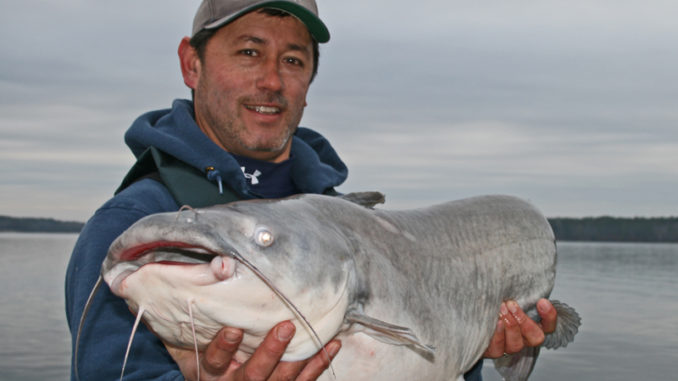
Anchor up, find bait and fish where big cats live
Fishermen who target catfish equate winter as the prime time to catch some outlandish-size blue catfish. Cold weather and big blues are a natural fit in South Carolina.
Top catfish guides agree on several factors that can help improve fishing success. These include selecting a lake that produces big blue catfish, locating forage and fish close together, not eliminating any depth of water, anchoring instead of drift-fishing, and finally, patience.
Guide Chris Simpson of Fightin Da Blues Guide Service (864-992-2352) targets huge blue catfish on several South Carolina lakes, and he has some specific ideas about big blue cats.
“We once caught a 97-pound catfish at Lake Monticello in the winter, and another year at almost the same time in that lake we caught an 80-pound-plus fish,” Simpson said. “This is the time of year for big catfish. To be successful, you’ve got to have a plan. It’s essential to fish where big blue catfish are known to frequent. In South Carolina, that list is growing as blue catfish expand their range. But the state has several hotspots.
Numerous S.C. lakes are prime winter catfish havens
For me, Lake Monticello is awesome during the winter. But big blues are caught at Lake Murray and Lake Wateree. Of course, both Santee Cooper lakes have plenty of huge fish, and anglers often overlook the Savannah River lakes. The first step is target a lake you know has big blue catfish.”
Second on the list is to find the right combination of forage and fish.
A good example is at Santee Cooper in December and into January, when anglers catch huge blues around big clusters of baitfish. Guide Alan Spence (803-478-5029) said in Lake Marion, gizzard and threadfin shad are forage keys. In Lake Moultrie, he said the list also includes menhaden.
“Another consideration is cold-weather catfish will not always be on the bottom. They will often hover around the pods of bait if suspended at mid-depths. And bait actually becomes the ‘structure,” Spence said. “Some anglers need to change their thinking process. Catfish don’t always feed on the bottom. Deep water can be great, but it’s not the only place to fish during cold weather.”
Guide Rodger Taylor (803-328-9587) employs shallow-water tactics very successfully on Lake Wateree and other lakes during the winter.
Shallow water can also hold winter catfish
“During the coldest days of winter, I get back in the back of creeks. I find baitfish and catch some huge blues in very skinny water,” he said. “I’ll often anchor in 2 to 4 feet of water, and I prefer mid-day and sunny skies when the forage is drawn into these areas and the big blues follow. Don’t overlook skinny water in extremely cold weather.”
Simpson said proper technique is important. Most guides agree that targeting a big fish by anchoring is often better than drift-fishing for a giant blue during winter.
“It can happen either way. But during cold weather, I prefer anchor-fishing to drifting for the biggest blue catfish,” Simpson said.
Simpson said a final tip for fishing any cold weather blue catfish destination is patience.
“I spend considerable time graphing for the right setup. So when I find it, I commit to that spot,” Simpson said. “I’ll typically stay at least 90 minutes and sometimes more if it really looks good or if that spot has produced monster blues in the past. A number of times, right after I literally gave the fish a verbal ‘5-minute warning’ shout-out we’ve hook a huge blue. Often that triggers a feeding spree, and we’ll hook two or three quickly. Sometimes, it’s just takes time and patience in cold weather.”
Click here to read more about freshwater fishing in the Carolinas.


Be the first to comment